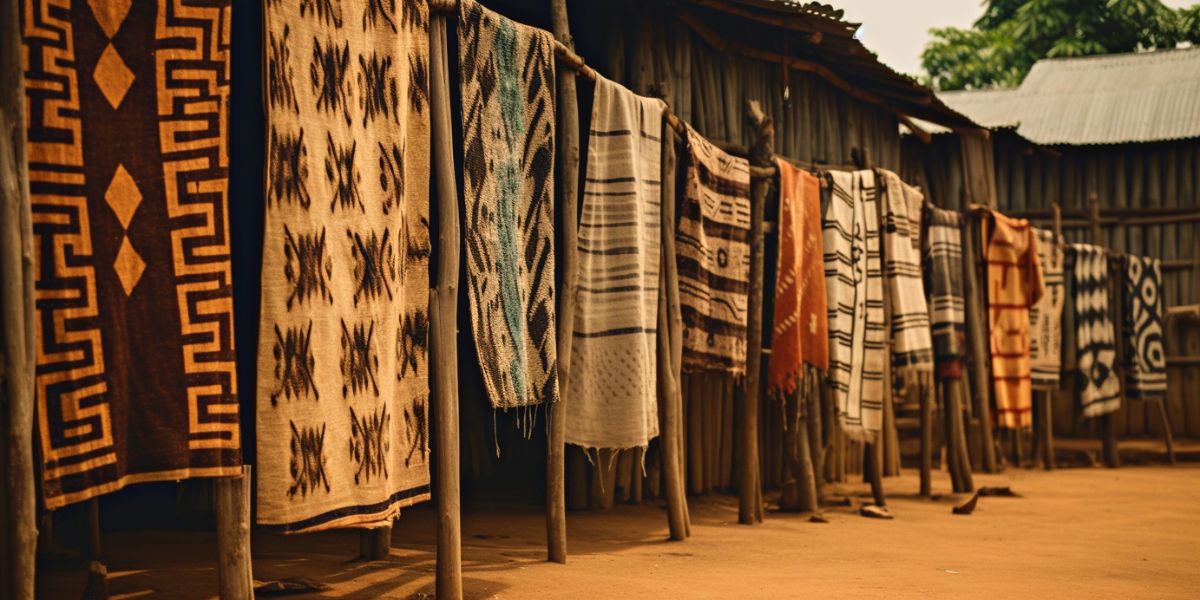Yes, African mud cloth, also known as Bogolanfini, can be washed. However, it is important to follow the care instructions provided by the manufacturer or any specific guidelines given for the particular cloth.
Dos and don’ts
Dos
- Read the care instructions: Always check for any specific care instructions provided by the manufacturer or artisan.
- Handwash if recommended: If possible, opt for handwashing to preserve the integrity of the mud cloth.
- Use mild detergent: Choose a gentle detergent suitable for delicate fabrics.
- Test for colorfastness: Before washing, test a small, inconspicuous area of the cloth to ensure that the colors do not bleed or fade.
- Wash in lukewarm water: Fill a basin or sink with lukewarm water to wash the mud cloth.
- Gently agitate: Swish the cloth gently in the water to loosen dirt and stains.
- Rinse thoroughly: Ensure that all detergent is thoroughly rinsed out by rinsing the cloth in clean water.
- Air dry in shade: Lay the cloth flat on a clean towel or hang it in a shaded area to air dry. Avoid direct sunlight to prevent color fading.
- Iron with low heat (optional): If desired, iron the mud cloth with a low heat setting or use a pressing cloth to protect the fabric.
Don’ts
- Don’t bleach: Avoid using bleach or any harsh chemicals that may damage the fabric.
- Don’t scrub vigorously: Be gentle when agitating the cloth to prevent fraying or damage.
- Don’t wring or twist: Avoid wringing or twisting the cloth as it may stretch or distort the fabric.
- Don’t use hot water: Do not use hot water, as it may cause the colors to bleed or fade.
- Don’t tumble dry: Avoid using a dryer, as it may shrink or damage the mud cloth.
- Don’t expose to direct sunlight: Protect the cloth from direct sunlight during drying to prevent color fading.
- Don’t iron with high heat: Use a low heat setting when ironing, and avoid ironing directly on the fabric without a pressing cloth.
Remember to always refer to any specific care instructions provided with your mud cloth, as they may vary depending on the fabric, dyeing techniques, or other factors specific to the piece.
5-step guide to washing African mud cloth
Step 1
Check the care instructions: Review any care instructions provided by the manufacturer or artisan. Follow their guidelines if available.
Step 2
Prepare for handwashing: Fill a basin or sink with lukewarm water. Gather a mild detergent suitable for delicate fabrics and a clean towel for drying.
Step 3
Gently wash the mud cloth: Immerse the mud cloth in the water and add a small amount of the mild detergent. Swish the cloth gently in the water, being careful not to scrub vigorously. Allow it to soak briefly to loosen dirt and stains.
Step 4
Rinse thoroughly: Drain the soapy water and refill the basin with clean water. Rinse the mud cloth by gently agitating it in the water to remove any remaining detergent. Repeat the rinsing process if necessary until the water runs clear.
Step 5
Air dry carefully: Gently squeeze out excess water from the mud cloth without wringing or twisting the fabric. Lay it flat on a clean towel or hang it in a shaded area to air dry. Avoid exposing it to direct sunlight to prevent color fading. Once dry, you can iron the cloth with a low heat setting if desired.
FAQs
Can I machine wash African mud cloth?
While handwashing is generally recommended for African mud cloth to preserve its integrity, some mud cloths may be machine washable on a delicate or gentle cycle. However, it is crucial to check the care instructions provided by the manufacturer or artisan for specific guidelines. When machine washing, use a mild detergent and ensure the water temperature and cycle settings are appropriate for delicate fabrics.
Can I use bleach to remove stains from African mud cloth?
No, it is not recommended to use bleach or any harsh chemicals on African mud cloth, as they may damage the fabric or cause colors to fade. Instead, opt for gentle cleaning methods like handwashing with a mild detergent. If you encounter stubborn stains, try spot cleaning with a mild stain remover specifically formulated for delicate fabrics, and test it on a small, inconspicuous area first to ensure it doesn’t affect the colors or fabric.
How do I prevent color fading when washing African mud cloth?
To prevent color fading when washing African mud cloth, there are a few steps you can take. First, always wash the cloth in lukewarm water, as hot water can cause colors to bleed or fade. Additionally, avoid exposing the mud cloth to direct sunlight during drying, as prolonged exposure can cause fading. Use a mild detrgent suitable for delicate fabrics and rinse the cloth thoroughly to remove any residual detergent that could contribute to color fading. Finally, if you choose to iron the cloth, use a low heat setting and iron it on the reverse side or with a pressing cloth to protect the fabric and colors.
Final thoughts 💭
African mud cloth, also known as Bogolanfini, can be washed to keep it clean and well-maintained. Handwashing is often recommended, using lukewarm water and a mild detergent suitable for delicate fabrics. Gently agitate the cloth to remove dirt and stains, and rinse it thoroughly to ensure all detergent is removed.
Air dry the mud cloth in a shaded area to prevent color fading, and if desired, iron it with low heat. It is important to follow any specific care instructions provided by the manufacturer or artisan and avoid using bleach or harsh chemicals that may damage the fabric. By following these best practices, you can wash African mud cloth effectively while preserving its beauty and longevity.





Leave a Reply